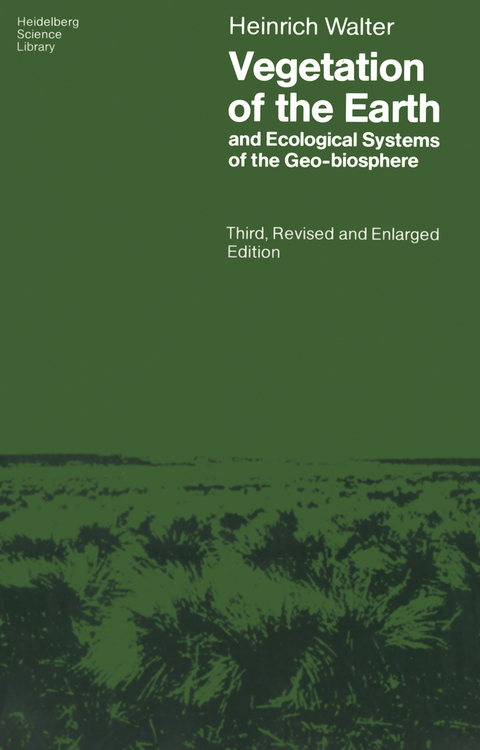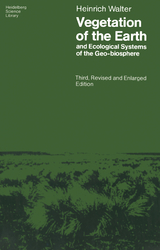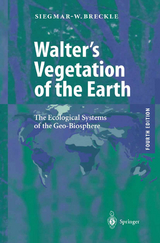Vegetation of the Earth and Ecological Systems of the Geo-biosphere
Springer Berlin (Verlag)
978-3-540-13748-1 (ISBN)
- Titel erscheint in neuer Auflage
- Artikel merken
Introduction: The Classification of Ecological Systems.- 1. The Aims of Ecology.- 2. Classification of the Geo-biosphere into Zonobiomes.- 3. Zonoecotones.- 4. Orobiomes.- 5. Pedobiomes.- 6. Biomes.- 7. The Nature and Structure of Ecosystems.- 8. Special Material Cycles in Terrestrial Ecosystems and the Role Played by Fire.- 9. Smaller Units of Ecological Systems: Biogeocenes and Synusiae.- 10. Diagrammatic Representation of the Hierarchy of Ecological Units..- General Section.- 1. The Historical Factor.- 2. Climate and Its Representation (Climate Diagrams, Homoclimes, and Climate-Diagram Maps).- 3. Environment and Competition.- 4. Ecotypes and the Law of Change of Biotope and Relative Constancy of Habitat. Extrazonal Vegetation.- 5. Poikilohydric and Homeohydric Plants and Halophytes.- Special Section.- I Zonobiome of the Equatorial Humid Diurnal Climate with Evergreen Tropical Rain Forest.- 1. Typical Climate.- 2. Soils and Pedobiomes.- 3. Vegetation.- 4. Anomalies in the Equatorial Zone.- 5. Orobiome I -Tropical Mountains with a Diurnal Climate.- 6. The Biogeocenes of Zonobiome I as Ecosystems.- Zonoecotone I/II Semievergreen Forest.- II Zonobiome of the Humido-Arid Tropical Summer-Rain Region with Deciduous Forests.- 1. General.- 2. Zonal Vegetation.- 3. Savannas.- 4. Parkland.- 5. Some of the Larger Savanna Regions.- 6. Ecosystem Research.- 7. Tropical Hydrobiomes in Zonobiomes I and II.- 8. Mangroves as Halohelobiomes in Zonobiomes I and II.- 9. Shore Formations Psammobiomes.- 10. Orobiome II Tropical Mountains with an Annual Temperature Periodicity.- Zonoecotone II/III Climatic Savannas.- III Zonobiome of the Subtropical Arido Climate with Deserts.- 1. Climatic Subzonobiomes.- 2. The Soils and Their Water Content.- 3. The Water Supply of Desert Plants.- 4. Ecological Types of Desert Plants.- 5. Salt Soils-Halobiomes.- 6. The Salt Economy of Halophytes.- 7. Desert Vegetation of the Various Floristic Realms.- 8. Adaptations to Water Stress from the Cybernetic Point of View.- 9. The Productivity of Desert Vegetation.- 10. Orobiome III-Desert Mountains of the Subtropics.- 11. Biome of the Namib Fog Desert.- Zonoecotone III/IV Semidesert.- IV Zonobiome of the Winter-Rain Region with an Arid-Humid Climate and Sclerophyllic Woodlands.- 1. General.- 2. Biome Group of the Mediterranean Region.- 3. The Significance of Sclerophylly in Competition.- 4. Mediterranean Orobiome.- 5. Climate and Vegetation of the Canary Islands.- 6. Arid Mediterranean Subzonobiome.- 7. Biome Group of the Californian Region and Neighboring Country.- 8. Biome Group of the Central Chilean Winter-Rain Region with Zonoecotones.- 9. Biome Group of the South African Capeland.- 10. Biome Group of Southwestern and South Australia with Winter Rain..- 11. The Historical Development of Zonobiome IV and Its Relationship to Zonobiome V.- V Zonobiome of the Warm-Temperate Humid Climate.- 1. General.- 2. Humid Subzonobiomes on the East Coasts of the Continents.- 3. Biome of the Eucalyptus-Nothofagus Forests of Southeastern Australia and Tasmania.- 4. Warm-Temperate Biome of New Zealand.- VI Zonobiome of the Temperate-Nemoral Climate.- 1. Leaf Shedding as an Adaptation to the Cold Winter.- 2. Distribution of Zonobiome VI.- 3. Atlantic Heath Regions.- 4. Deciduous Forests as Ecosystems (Biogeocenes).- 5. The Effect of the Cold Winter Period on Plants of the Nemoral Zone..- 6. Orobiome VI-The Northern Alps.- Zonoecotone VI/VII Forest-Steppe.- VII Zonobiome of the Arid-Temperature Climate.- 1. Climate.- 2. Soils of the East European Steppe Zone.- 3. Meadow-Steppes on Thick Chernozem and the Feather Grass Steppes.- 4. North American Prairie.- 5. Ecophysiology of the Steppe and Prairie Species.- 6. Asiatic Steppes.- 7. Animal Life of the Steppe.- 8. Grass Steppes of the Southern Hemisphere.- 9. Subzonoecotone of the Semidesert.- 10. Subzonobiome of the Middle Asiatic Deserts.- 11. Biome of the Karakum Desert.- 12. Orobiome VII(rIII) in Middle Asia.- 13. Subzonobiome of the
| Erscheint lt. Verlag | 1.7.1985 |
|---|---|
| Reihe/Serie | Heidelberg Science Library |
| Übersetzer | Owen Muise |
| Zusatzinfo | XVI, 318 p. |
| Verlagsort | Berlin |
| Sprache | englisch |
| Maße | 155 x 235 mm |
| Gewicht | 570 g |
| Themenwelt | Naturwissenschaften ► Biologie ► Botanik |
| Naturwissenschaften ► Biologie ► Ökologie / Naturschutz | |
| Naturwissenschaften ► Geowissenschaften ► Geografie / Kartografie | |
| Schlagworte | Biome • Biosphäre • biosphere • classification • earth • Ecology • ecosystem • Environment • Habitat • Klima • Ökologie • Pflanzengeographie • Pflanzenökologie • Physiology • Population • Rain • Temperature • Terrestrial ecosystem • Terrestrial Ecosystems • Vegetation • Vegetationsgeographie • Vegetationsgeographie / Pflanzengeographie • Zonobiom |
| ISBN-10 | 3-540-13748-3 / 3540137483 |
| ISBN-13 | 978-3-540-13748-1 / 9783540137481 |
| Zustand | Neuware |
| Haben Sie eine Frage zum Produkt? |
aus dem Bereich





